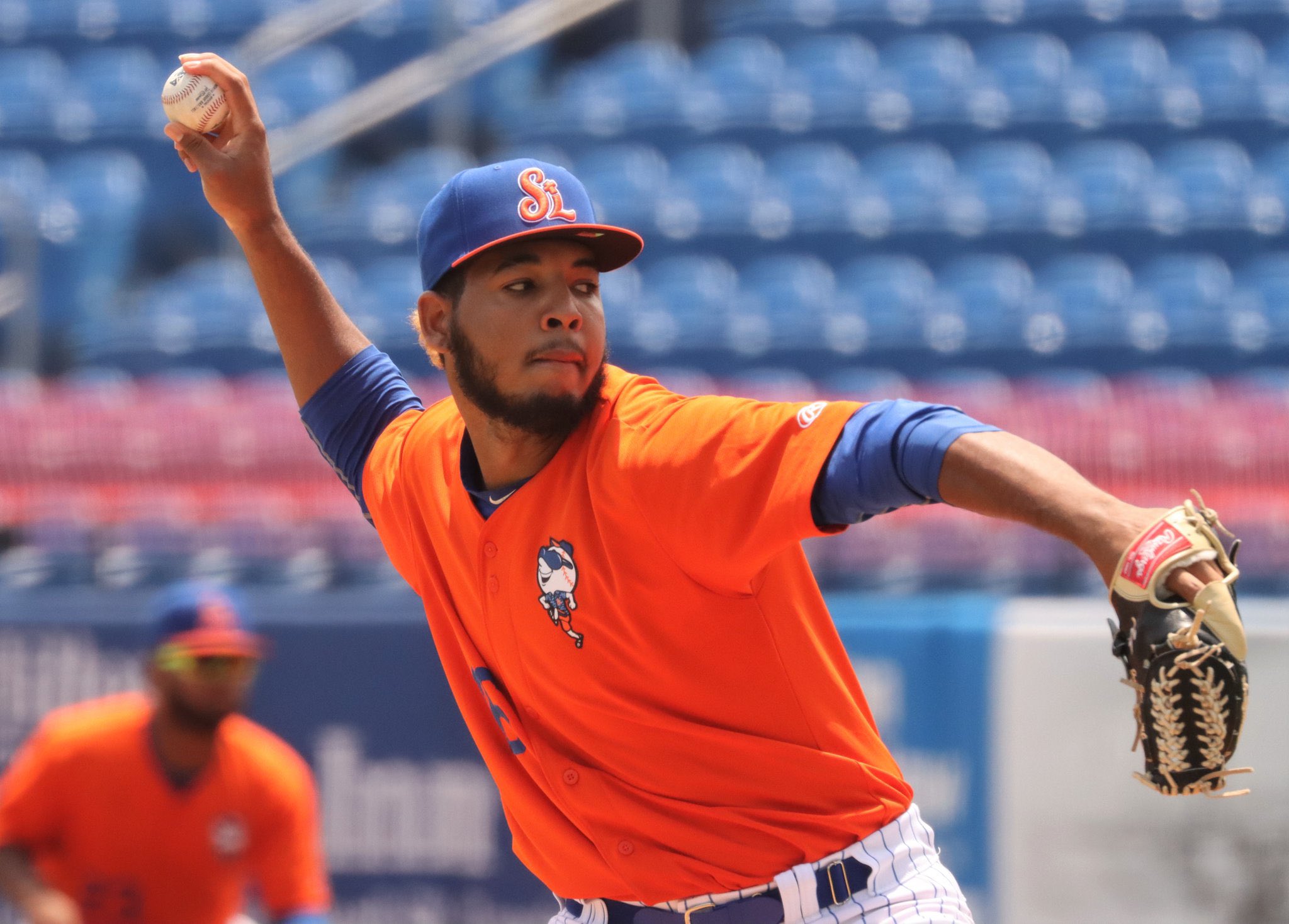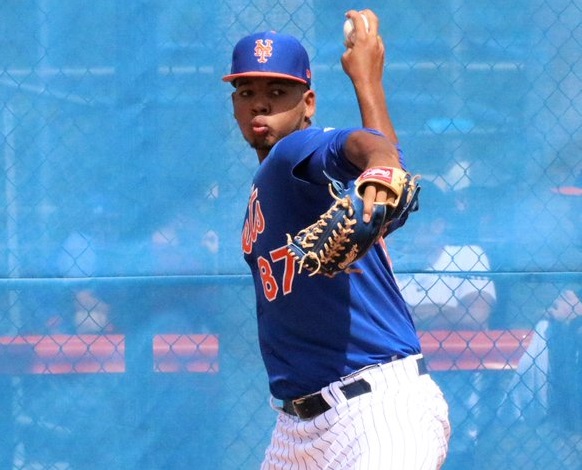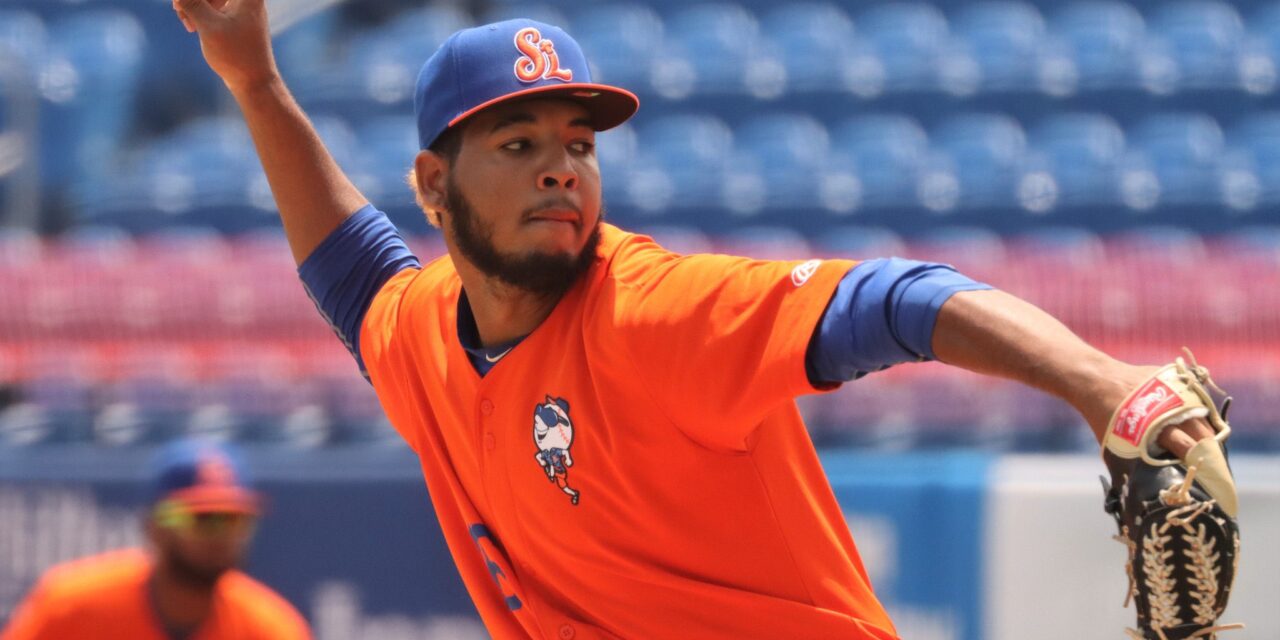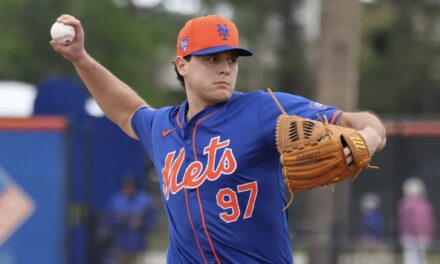
Junior Santos. Photo by Ed Delany of MMO
The New York Mets’ 19th-ranked prospect, per MLB Pipline, is Junior Santos. The 21-year-old starting pitcher is entering a crucial year in his first crack at the upper minors (with Double-A Binghamton).
He was “Rule-5” eligible for the first time last winter, so he should have the goals of being added to the 40-man roster this winter and/or even making it up to the big leagues at some point. If he does make it to the majors, it’d likely resemble a José Butto-type ascent.
Santos still has a ways to go to be an MLB mainstay, but with a few tweaks he might just get there. His elite fastball and intimidating six-foot-six frame are a scout’s dream. Further, his slider development shows that he is still getting better year-to-year.
Short-Term Goal: Continue Changeup Development
It’s obvious Santos’ changeup development is high priority in the eyes of the Mets. This is evident by the fact he has been working on it in all of his side sessions. His changeups in years’ past have held more vertical break than his fastball while being less than 10 mph slower. Both of these characteristics have led to the pitch being by far his worst graded. He needs to either decrease it’s velocity or decrease it’s vertical break.
The Mets have had him experiment with a splitter, but he has struggled to command it and the shape is inconsistent. Typically, splitters are more difficult to command and his ability to throw a sinker with seam-shifted wake (less than 80 percent spin efficiency) indicates a more natural changeup should be a plausible option.
By this point in his career, it is expected that he would have found a better shape for his changeup. Due to this, he might be trying to induce the movement in an improper way (counterintuitively, simply throwing the changeup like his fastball with an offset grip should do the trick given the shape and nature of his fastball).
Santos should elect to pursue the pitch he is most comfortable with (splitter versus traditional changeup) and go from there. Seam orientation of the current pitch may also be an issue.
The splitter option would require consistency and repeatability, getting repetitions daily in catch play and on the mound, and using the data to get feedback on how certain changes impact the vertical break. The traditional changeup would be a simpler solution.
Looking at his current grip, his index finger is still too dominant on the ball, leading to a lack of velocity separation from his fastball and likely too much backspin. He should take the index finger off the ball so that he throws the pitch more with his third and fourth fingers. If he is unable to lower the vertical break, decreasing the velocity as much as possible would be an effective compromise on the pitch, keeping hitters off balance and increasing his fastball effective velocity.

Junior Santos. Photo by Ed Delany, MMO
Long-Term Goal: Add a Curveball or Bring Back His Four Seam
Santos has done a great job of increasing velocity on his slider in recent years. Back in 2018, his fastball averaged 92 mph and his slider of a similar shape was just 79 mph. Given that typically breaking ball velocity increases at a 3-to-4 ratio relative to fastball velocity, his current 95.4 mph average fastball compared to his 85 mph average slider shows that his slider’s pitch grade has improved significantly from 2018 and subsequent years independent of his increase in fastball velocity.
As he continues developing his changeup, long term, transitioning away from a two-pitch starting pitcher will help him maintain success deeper into his outings. Curveballs, even if below average, can be great additions to an arsenal as a starting pitcher because the swing percentage against is extremely low in certain counts.
It would allow him to steal strikes to get ahead of hitters and to get even in counts with minimal risk. It would also be best for his long-term development to start working on the pitch as soon as possible to allow for a higher degree of comfortability in the future.
https://twitter.com/drivelinebases/status/1642978534066118658?s=46&t=g8AXmyVVLA8cxWIqRMXmOQ
Santos can also add back his four-seam fastball of years’ past. This would be a swing-and-miss pitch if properly located at the top of the zone and likely bring his strikeout percentage closer to league average, stretching the zone vertically.
This would match his arsenal similarly to Sandy Alcántara’s and Santos showed that he had the ability to separate the two pitches (less than five inches of separation between his sinker and four-seam in 2021).
In instructing Santos to use the four-seam as a purposeful whiff pitch, I would explain why his sinker should be thrown down and the four-seam up, to make the hitter swing over and under the ball, respectively. Alcántara does a great job of separating the location on his sinker and four-seam fastballs.
Something To Watch For: High Fastball Usage Behind In The Count
At least five of his six walks across his first three starts of the season were on fastballs, and his fastball usage behind in the count was higher than in other counts. This predictability would lead to more damage against and a higher walk rate than would otherwise be expected.
The in-zone rate with his slider was 58% compared to a 49% rate with his fastball in his first start, while the strike percentages flipped in his second outing. As of after his second start, his fastball is in the 80th percentile and his slider is in the 81st percentile for in-zone percentage.
Worth noting, increasing slider usage behind in the count would open the zone up, leading to a higher chase rate in hitter advantaged counts and an overall increase of in-zone rate.
Summary
At still just 21 years old, Santos is close to being a projectable MLB starter with his plus fastball and improving slider. His fastball has continually improved as both his velocity and movement profiles are better year-to-year (up to 98 mph and 6.6″ vertical break average on April 8). Further, his fastball leads to a high ground ball rate (60th percentile in the minor leagues) which is great for a starting pitcher with a sinker profile and his walk rates have been better than league average.
To improve results deep into outings he needs to add to his arsenal, throwing more change-ups and, eventually, add a fourth pitch via a bigger breaking ball or a four-seam fastball. There is likely low-hanging fruit in regards to these secondary pitches (grip, mentality, seam orientation, etc) too. Though, will be exciting to watch Santos continue to grow this season with Double-A Binghamton.
















